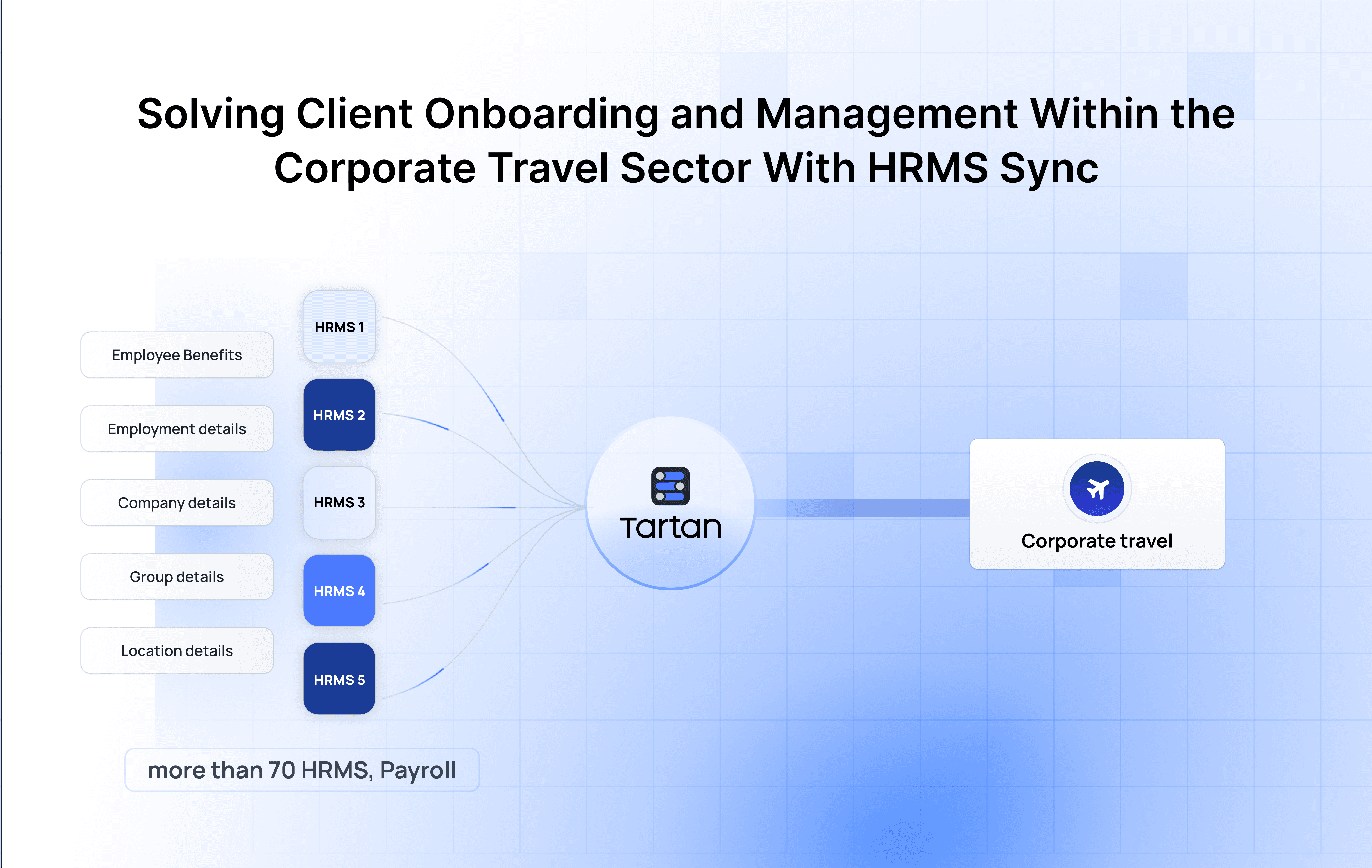
Jul 10, 2024
Solving Client Onboarding and Management Within the Corporate Travel Sector With HRMS Sync
We recently hosted a webinar focused on HRMS Sync Integration, bringing together industry leaders to explore challenges and solutions in client onboarding and management within the corporate travel sector. During the event, we discussed a recent study revealing that 37 percent of Client Account Managers (CAMs) and Customer Success Managers (CSMs) spend significant time sourcing, sorting, and syncing data due to manual data-sharing systems. The webinar aimed to address these concerns by providing insights and solutions to some of the most pressing questions raised by industry leaders.
The webinar kicked off with an overview of the HRMS Sync. Our Head of Product, Hemanth Bhatia, shared his expertise in streamlining client onboarding and data synchronization processes specifically for corporate travel companies. He provided a comprehensive view of how integrating HRMS Sync with your client’s systems can address critical issues in the corporate travel industry, mainly focusing on data management, security, and integration efficiency.
Throughout the webinar, our expert and industry leaders touched on several critical points:
Challenges in Client Onboarding and Data Management
One significant insight discussed was the complexity and inefficiency of client onboarding and data management within the corporate travel industry. The manual processes involved in data synchronization, such as CSV uploads and SFTP transfers, are prone to errors, delays, and security risks. HRMS Sync addresses these issues by providing a Unified API integration that normalizes data from over 70 HRMS systems.
Real-Time Data Synchronization
Another key point was the importance of real-time data synchronization. HRMS Sync allows businesses to receive real-time updates on new joiners, exits, and other employee changes. This ensures that systems are always up-to-date, reducing the risk of unauthorized access and providing services to the right employees at the right time.
These insights are crucial for corporate travel providers as they navigate the challenges of managing extensive client data efficiently and securely.
Furthermore, there were several key questions answered during the webinar -
How much time does it take to integrate with HRMS Sync, and what manpower is involved?
How frequently is the data updated through HRMS Sync?
How would we be notified about any new employee joining or exiting?
What are the benefits of using HRMS Sync in terms of client management?
Can we apply condition rules to the data?
How does HRMS Sync handle data security?
Below are the highlights from the webinar. To learn more about HRMS Sync, you can also directly connect with our HRMS Sync solution expert.
How long does it take to integrate HRMS Sync, and what manpower is involved?
The integration of HRMS Sync is designed with efficiency in mind, aiming to minimize the time and resources required from your team. Typically, the integration process can be completed within a week, depending on the complexity of your existing systems and the specific requirements of the integration. Generally, only one developer from your team is needed to manage the integration process. This developer will work with the HRMS Sync support team to configure the API according to your system's data format and structure.
The integration process can be expedited if your system consumes data in a compatible format. HRMS Sync’s team can create custom API responses that align with your existing data models, reducing the need for extensive modifications or data transformation. This approach not only accelerates the go-live time but also reduces potential integration challenges, making the process smoother and more predictable
How frequently is the data updated through HRMS Sync?
HRMS Sync offers flexible data update frequencies to match your organization's unique needs. The system allows you to set the update intervals based on the volume of changes and your operational requirements. For larger enterprises, where employee data might change frequently, daily updates are recommended to ensure that all modifications—such as new hires, role changes, or exits—are promptly captured and reflected in your systems.
For smaller organizations with less frequent changes, updates can be scheduled every three days or at other intervals that suit your operational pace. The flexibility in scheduling allows you to balance the need for up-to-date information with the system resources and bandwidth considerations. This approach ensures that your HR data remains current without overwhelming your systems with unnecessary updates, making the process both efficient and resource-effective
How would we be notified about any new hires, role changes, or exit of an employee?
HRMS Sync updates you about changes in your workforce, such as new hires or employee exits, through real-time API notifications. The system uses webhooks, automated messages sent from the HRMS to your designated endpoints. When a new employee joins, or someone leaves the organization, HRMS Sync immediately triggers an API call to your system’s webhook, delivering the updated data instantly. This ensures that your HR and related systems, such as payroll or project management tools, always have the most current information, allowing for timely updates and decision-making. This automation is critical for maintaining seamless operations, especially in larger organizations with frequent employee turnover or new hires.
Webhooks are preferred because they push the data as soon as changes occur, unlike traditional polling methods, which require systems to check for updates regularly. This means your system receives real-time updates without manual intervention or scheduled checks, thus minimizing the chances of outdated information being used in critical processes.
What are the benefits of using HRMS Sync in terms of client management?
HRMS Sync offers significant advantages in client management by improving the efficiency and effectiveness of your Customer Success Managers (CSMs). By automating the extraction and synchronization of HR data, HRMS Sync reduces the manual workload on CSMs by 30 percent, freeing up their time to focus on more strategic tasks such as acquiring new clients. This automation allows CSMs to manage more clients simultaneously without sacrificing service quality, thus improving the client-to-CSM ratio.
With HRMS Sync, CSMs can quickly access up-to-date and accurate client data, providing timely support, anticipating client needs, and addressing issues proactively. This enhances client satisfaction and strengthens client relationships, leading to higher retention rates and potentially increasing your business’s growth and profitability. Additionally, the reduction in manual data handling lowers the risk of errors, ensuring that client interactions are based on accurate and reliable information
Can we apply condition rules to the data?
HRMS Sync allows you to set up condition rules to automate workflows based on specific criteria. This means you can define certain conditions that trigger automated actions, such as sending notifications, updating records, or generating reports. For example, you could set up a rule that automatically alerts a manager if an employee's attendance falls below a certain threshold. This level of customization enables organizations to tailor the HRMS to their unique operational needs, streamlining processes and enhancing efficiency.
How does HRMS Sync handle data security?
HRMS Sync emphasizes data security and privacy. The system is designed to comply with relevant data protection laws and regulations, such as GDPR in Europe or CCPA in California. It includes data encryption, secure user authentication, and role-based access controls, ensuring only authorized personnel can access sensitive employee data. Regular security audits and updates are also part of the system's maintenance to safeguard against emerging threats.
HRMS Sync can handle complex client data and increase your client-to-CSM ratio
This concludes the webinar recap with a reminder of HRMS Sync's transformative potential for businesses dealing with complex client data management challenges. By automating data synchronization and providing real-time updates, HRMS Sync helps organizations improve efficiency, enhance security, and deliver better client services.
We hope the insights shared during the session will help you streamline client onboarding and data management processes, ultimately improving service delivery and client satisfaction.
Tartan is successfully serving several industries, including the corporate travel sector. Contact our HRMS Sync solutions team to integrate your client's systems with HRMS Sync.
Pramey Jain
CEO & Founder




